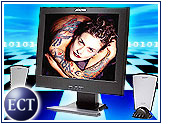
U.S. schools will spend nearly US$6 billion on technology before the 2003-2004 school year is over, much of it on wireless PDAs. Why do small screens have such a big impact on K-12 students and their teachers?
For one thing, they’re just the right size, said Elliot Soloway, a professor of education and computer science at the University of Michigan. Soloway, who has conducted technology-related educational research for much of the last 20 years, said giving laptops to students is nice, but impractical for two reasons.
First, laptops come with three-digit price tags, while handheld computers (when purchased in bulk) sell for less than $100. Second, handhelds’ smaller size is an advantage when it comes to packing a backpack. And, he said, “You’ll never hear a kid complain, ‘The screen is too small!’ That’s an adult talking.”
Using Them for Years
Assuming you buy Soloway’s initial arguments and agree that someday handheld computers should be introduced in K-12 classrooms, he’ll press on. He’ll say, “Math teachers have been using them for years. They’re called graphing calculators.”
He’s right, of course. Only now, they’re not just in math classes.
Texas Instruments graphing calculators are used in about 85 percent of U.S. public high schools. Instead of waiting for relative newcomer Palm to descend on its customer base, TI has wisely introduced free apps and curriculum for history and social studies teachers.
Last spring, TI introduced a wireless hub so teachers could download homework assignments, grade quizzes and manage student records on the units we might call the “original” handheld computers.
And while TI might be entrenched in the upper grades, Palm has won a bevy of fans in elementary schools.
Handheld Spells Success
What’s your average fifth grader doing at 8:30 in the morning? If he’s in Jan Kelly’s class in Mogadore, Ohio, he’s probably using a Palm to check his stock portfolio.
Kelly’s students start the year by investing an imaginary $2,000 in the market. Later, the students form their own companies and must sell their stock to fellow classmates to make a profit. Throughout the lesson, they use the Palms to do market research, create sales presentations and manage their company finances.
Is it a game? Kelly probably wouldn’t care if you called it that. What she cares about is “active engagement.” With Palms in hand, students can direct their learning. “I call it emergent curriculum,” she told TechNewsWorld.
While Kelly’s fifth graders play the market, Karen McClain, a special education teacher in Stow, Ohio, uses Palms in her classroom of second, third and fourth graders. Like Kelly, McClain began using the units when she participated in the Palm Educational Pioneer (PEP) research program at Kent State University’s Research Center for Educational Technology (RCET). PEP participants were asked how handheld computers can improve teaching and learning.
McClain’s quick answer: in spelling lessons.
Students with learning disabilities often have poor handwriting, McClain said. On paper, they tend to lag in spelling. Allow them to tap out spelling words on a keyboard, however, and McClain said you’ll often find they can spell on grade level. On the other hand, if spelling lessons suffer because of poor handwriting, writing skills soon will suffer too.
An added benefit McClain and Kelly mentioned they enjoy thanks to the handheld lessons: They both use “a lot less paper” in the classroom.
Change Brewing
While educators like McClain and Kelly might be content quietly reaping the benefits of handheld lesson plans, Soloway is anything but quiet about what he sees as a necessary revolution.
Soloway recalls his own education in the 1960s, when students routinely shared textbooks. “Then one day you walked in, and there were 30 or 40 [paperback] copies of Beowulf sitting there,” he said. “When each student had his own book, that changed the nature of the work teachers could assign.”
Inevitably, handheld computers will bring fundamental changes to education, he added. “One day, the kids will all walk in to class, flip open their Palms and look up at the teacher. Then what are we going to do?”
Neanderthals, Meet the Cooties
If Soloway has his way, we might give the kids Cooties.
In “Cooties,” a handheld computer game designed for classroom use, the teacher’s goal is to infect the students’ computers with a virus. In the process, Soloway said, students learn about germs, how they spread and how antidotes and vaccines work.
Cooties was developed by GoKnow, a private company founded by Soloway and two colleagues. GoKnow sells educational software for handheld devices and consulting services for schools that employ the technology. But Soloway isn’t ready to leave academia for sales. For one thing, he’s not done needling the critics in education.
He told TechNewsWorld that some of the greatest resistance to putting technology in the classroom comes from other educators, whom he calls “Neanderthals.”
While the word “Neanderthal” isn’t included in U.S. Department of Education press releases, Secretary of Education Ron Paige made a similar point earlier this year. When introducing the department’s latest technology plan, Paige noted, “Education is the only business still debating the usefulness of technology” — which might be government-speak for, “If your boss questioned your need for a laptop, wouldn’t you call him a Neanderthal?”
Getting a Grip on Administration
When QED president Jeanne Hayes announced the latest School Market Trends Study of Technology Purchasing, she noted that many districts have turned to handhelds to manage data. Thanks in part to the federal No Child Left Behind Act, U.S. teachers and administrators must complete an increasingly long and detailed list of reports, including achievement by ethnic background and other groups as well as overall academic progress.
According to the QED study, the student information systems software market is expected to jump by nearly a half-million dollars this year to $7.83 million.
That said, Hayes said the study shows that handhelds have moved beyond the administrative realm. She told TechNewsWorld that although “PDAs were first given to and used by administrators, including school principals, more recent adoptions for classroom and entire-grade use are, clearly, for instructional purposes.”
In other words, the use of handhelds in education is spreading — like a case of the Cooties.

















































Why They Are Spending That Much of Amount! most of the Students Suffering to Speak, Read, Write in English lack of Proper Skills. We Developed English language lab software. this is gives completely different experience from the traditional system of learning languages and teaching, offering advanced features and functionalities.
I don’t suggest that handheld computers (or any other type) can fix all that needs fixing in our schools. In researching this topic, I did find that handhelds are a viable tool that can help teachers teach in a way that is very comfortable and accessible to children of all abilities. Tony Vincent, a 5th-grade teacher in Nebraska (see how his classroom works at http://www.planet5th.com) said it well when he said, "I don’t teach technology…I use technology to teach."
Re: Education and Technology: The Future of Handheld Computers by Diane Stresing.
Why are you supporting spending millions on PDAs for grade school children, when there aren’t enough funds for the basics – like textbooks, teachers’ salaries, smaller classrooms and new schools? Grade school children would lose and break PDAs. So many of our grade schoolers can’t speak English, read, spell or even hold a pencil correctly. Grade school is the time to get a solid foundation in the basics of reading, writing, math, art, music and science, and much of the time students aren’t mastering these skills. I can see some computer training by 3rd grade when their hands are large enough to handle the keyboard, but computers are not the answer to the many ills of our failing educational system. Without a solid foundation students are doomed to fail later in school and life – computers or not.